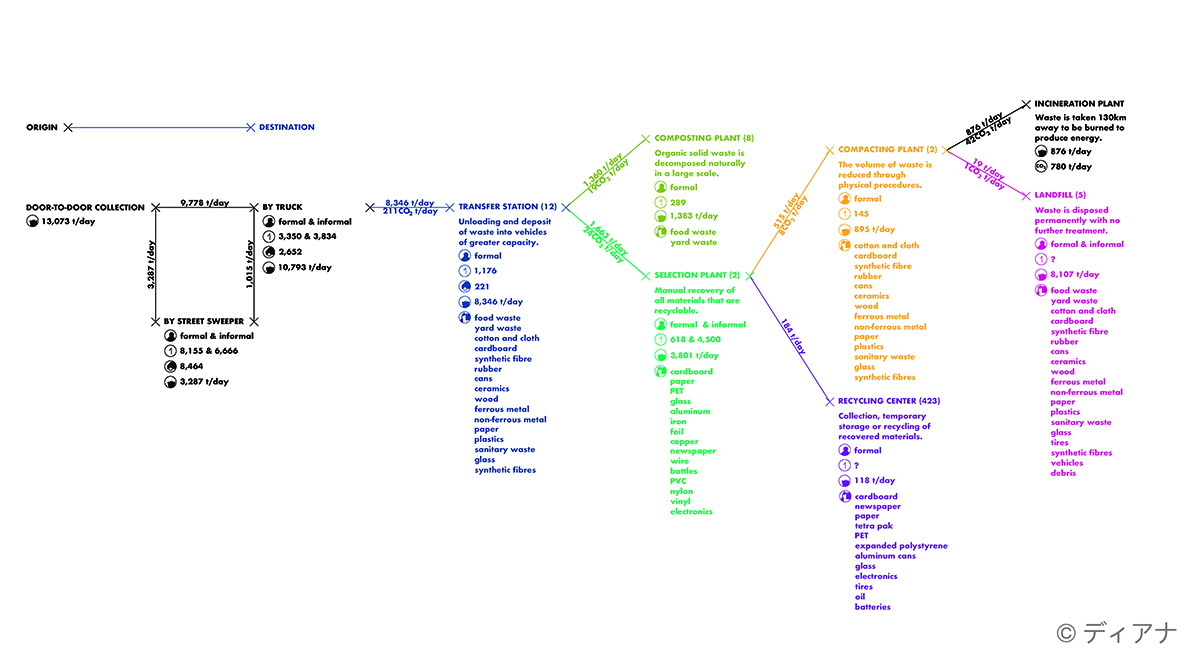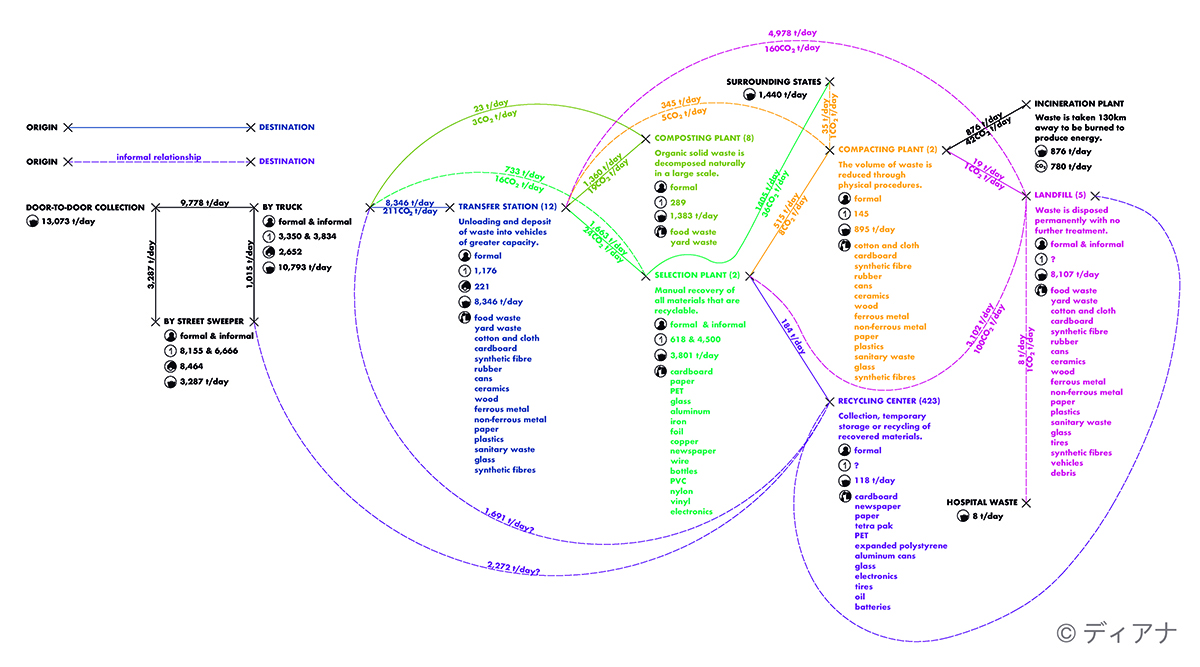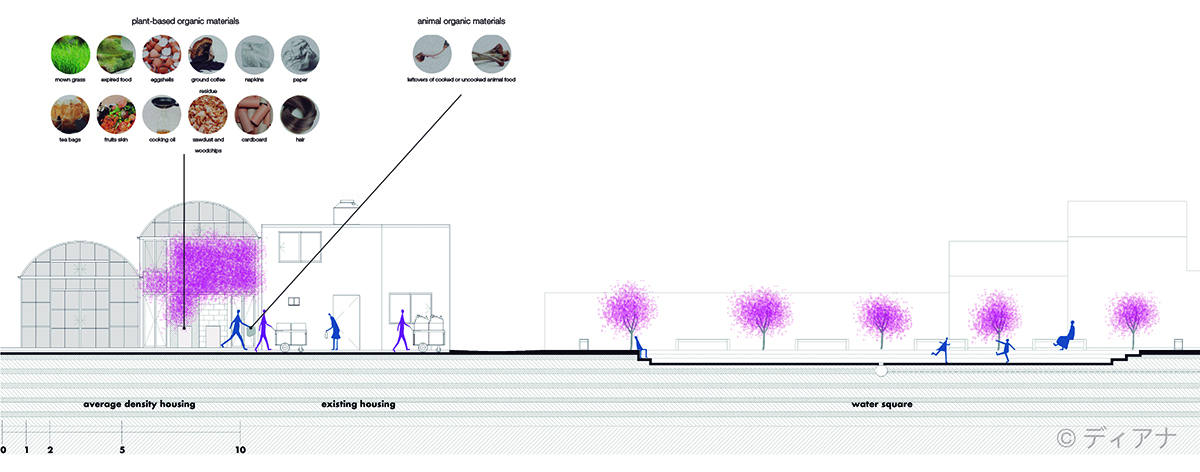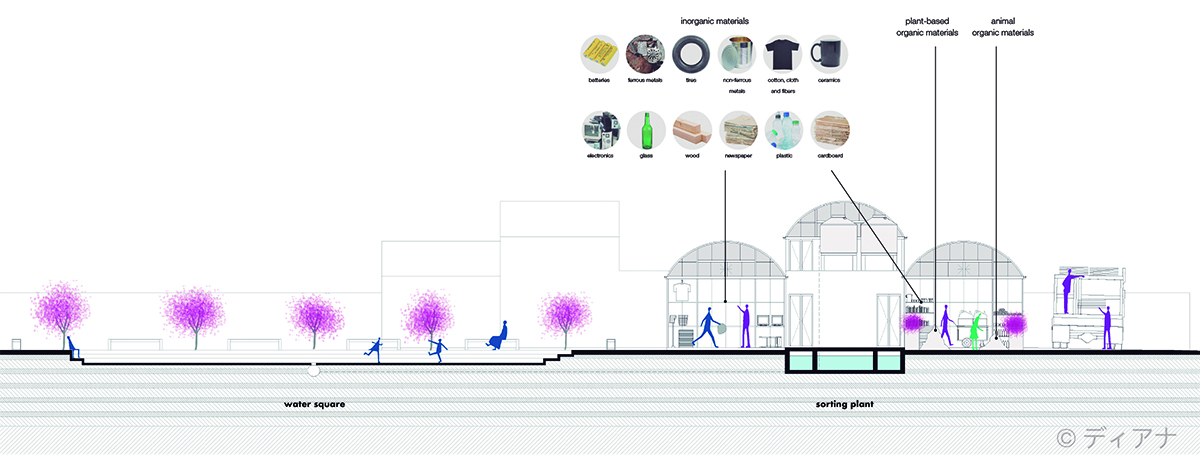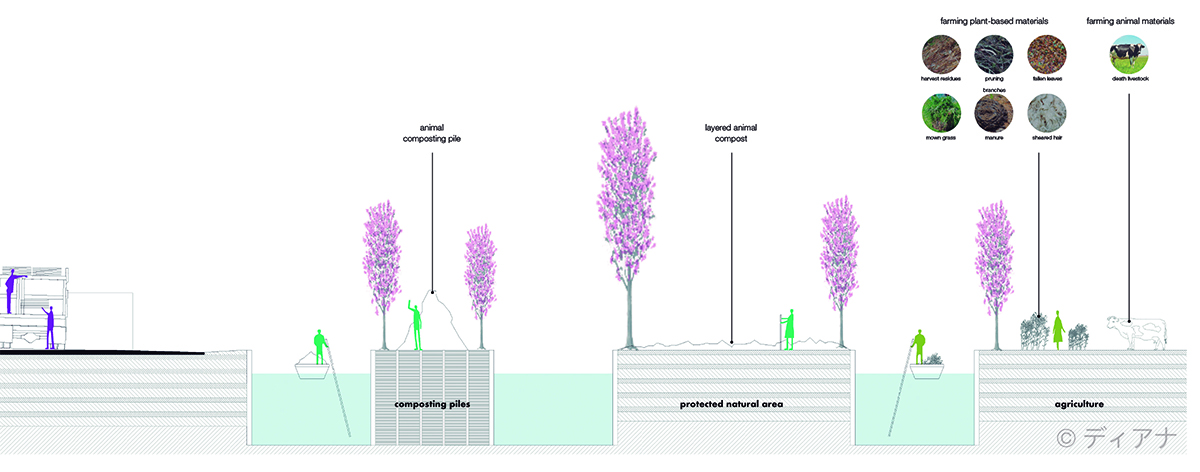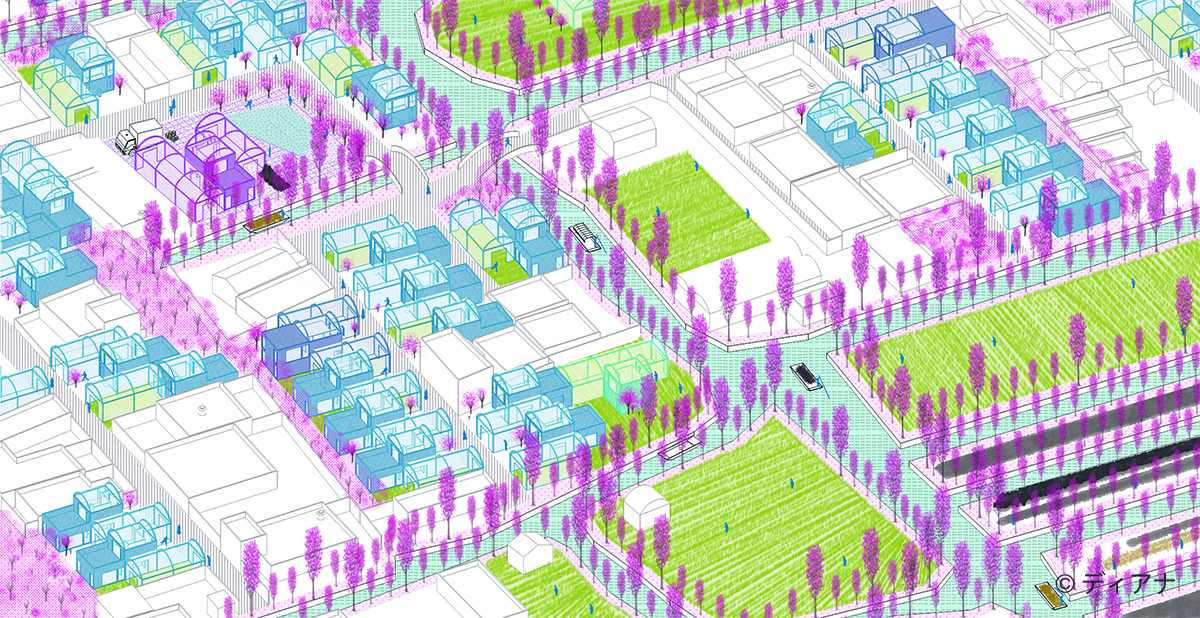
Here and Within A Local Waste Management System
Master Thesis
When mapping the flows of the waste management system in Mexico City (from door-to-door collection to disposal in landfills), parallel informal flows also materialised challenging the whole process. In theory, only 19 tons of waste per day arrive to the landfills. However, when considering the informal flows, landfills take in more than 8,000 tons of waste per day from the 13,000 tons produced. Waste ends outside Mexico City; moved inefficiently all around the city and releasing tons of CO2 into the atmosphere every day with its transport.
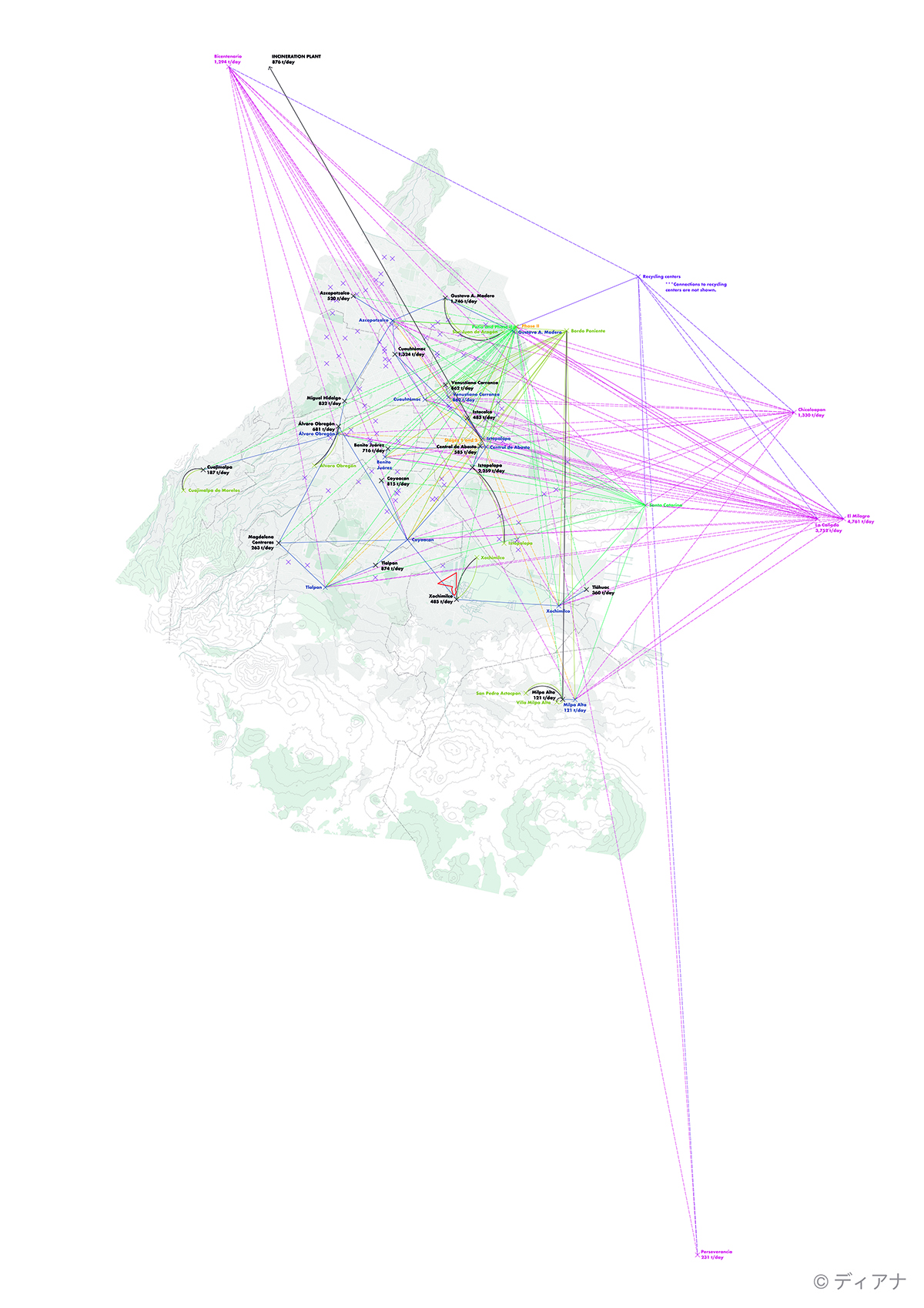
0. Content
1. Far and Out
Landfills have been moving for more than 500 years with the constant growth of the city under a “far and out” strategy of the government, every time they move they do further from the center due to this derogative conceptualisation of waste and the inherent characteristics of landfills. Then, my proposal is the opposite approach ‘Here and Within: a local waste management system’. So waste that usually ends kilometers away is handled in the community where it was produced.
I suggest that the ‘magical act of disappearance’ of trash is the reason why only 10% of all the waste in Mexico is recycled. I urge the need of local management of trash to understand waste as something we can live together with and to lengthen the life cycle of materials. I understand this as a system that might be replicated in other areas of Mexico City.
2. Selection Infrastrutures
The parts of the system where informality is found are the ones related to the process of selecting valuable materials. Basically, all recycling in Mexico City is done by informal workers.These are three moments in the waste collection system:
- The informal workers collect waste from door to door and sell the valuable materials to recycling centres or to the garbage trucks.
- What arrives to the selection plant is selected again by informal workers who collect it and sell it.
- The few valuable waste that arrives to the landfills is selected again by informal workers that live there.



3. Xochimilco Waste Infrastructure
3.1 Why Xochimilco
-
Xochimilco is not one of the greatest producers of waste in Mexico City. However, I chose to work with this municipality for 3 reasons:
- This municipality has the largest amount of informal settlements and the government does not allow the collection of waste in these areas.
- The area is characterised by its agricultural practice whilst it is still inside the city. However the waste management system does not provide a sorting process to differentiate the agricultural waste from the urban waste. Both are produced in the same household, mixed and all disposed as urban waste.
- Mexico City was built over a system of interconnected lakes. Xochimilco is the last remaining original landscape. It is an area formed of islands called ‘chinampas’ surrounded by canals. Collection becomes a challenge as garbage trucks or carts cannot reach the areas surrounded by water.
3.2 Urban Structure
Xochimilco is a pre-Hispanic community. Its historic district was developed with colonisation in the 16th century. In 1950’s started its modern urbanisation. Infrastructure for the Olympic Games in 1968 was also developed. However, after an unplanned urban development of Mexico City, this became the last remaining area of a historical landscape. In 1982 it was appointed Protected Natural Area by the government. It is also protected by UNESCO and considered a RAMSAR site due to the importance of the wetlands for the ecosystem.
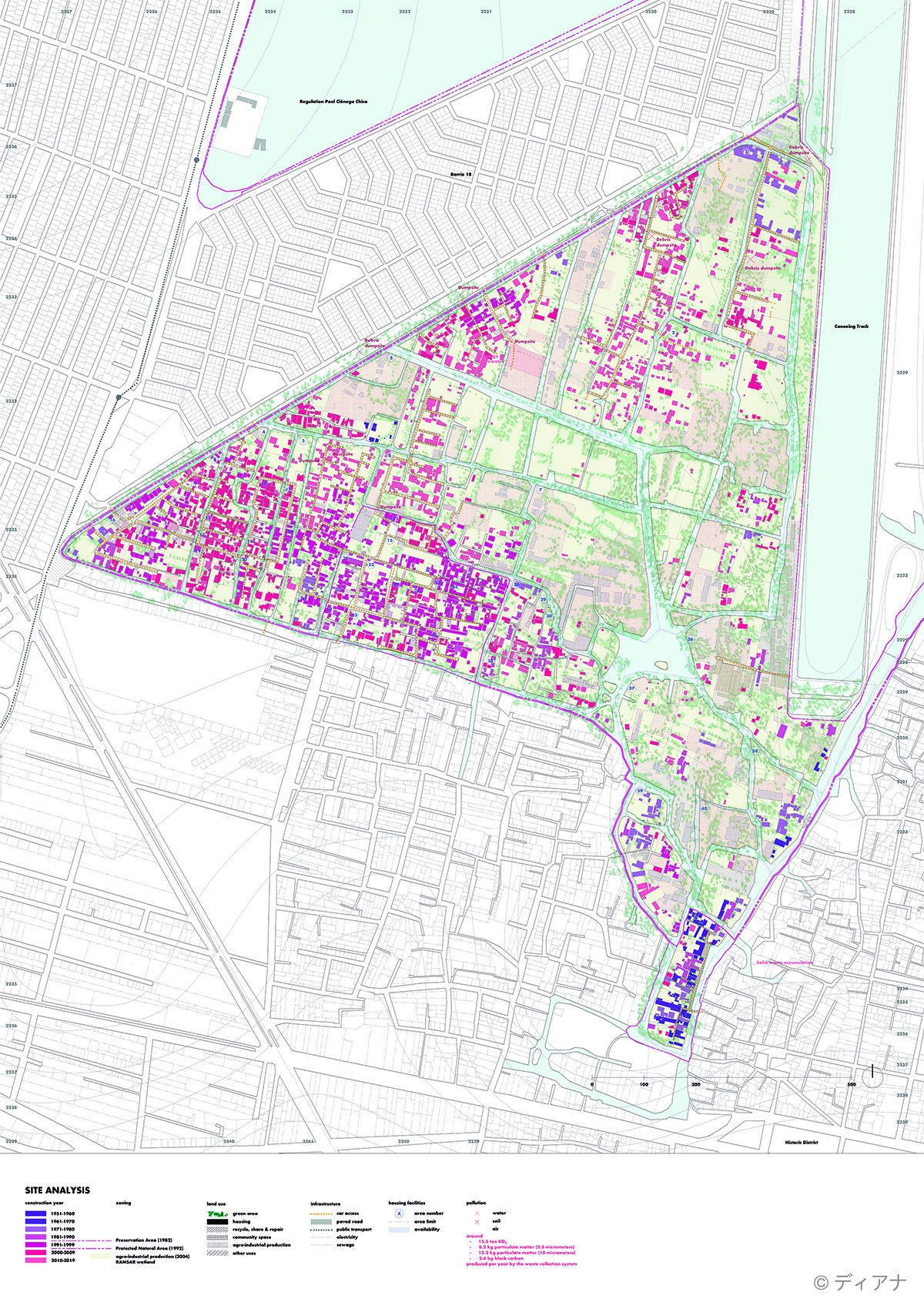
All the housing units inside the Protected Natural Area became illegal together with the construction that followed although the existing regulations. Only two areas in the south part were removed from the boundary and are now legal. These neighbourhoods are where most of the services are available. The principal problem is water accessibility. Most of the other services are solved illegally. Infrastructure is also solved independently. Likewise, construction materials are contrasting, 40% of the structures are built with temporary materials.
In terms of land use, the site is only intended for agro-industrial production and protection of the ecosystem. That includes agriculture, farming, sport fields, and schools, for example. Besides agriculture, the main economic activities in the area involve retail in the ground floor of most of the housing units. There are not community or gathering spaces (besides the streets). There is only a playground area, two community kitchens and several altars around the neighbourhood. There are several recycling facilities, in the attempt to gathering valuable materials and making a living out of their sale.
4. Proposal
4.1 Master Plan
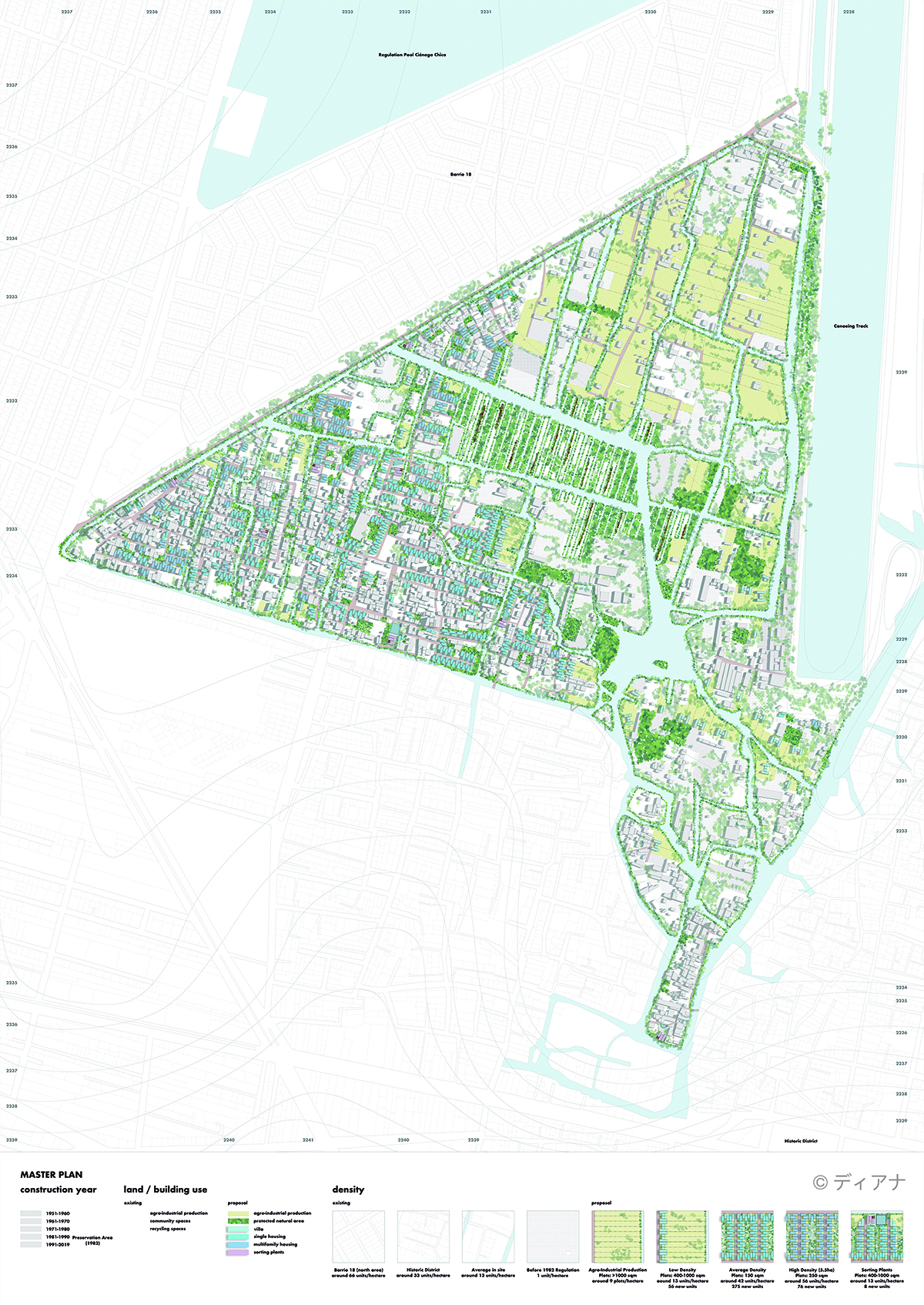
Then, I would like to take this as an opportunity to make the different approaches along history work together; restoring the wetlands as part of the Protected Natural Areas, respecting the uses that are formal (agro-industrial production), preserving the housing areas that existed before 1982, reinforcing the autonomy of the community by designing a local waste management system; and reclaiming the right to occupancy of the land by turning the inhabitants into the protectors of the protected natural area.
The proposed system is based on the materials that are used and produced by each elements. It starts with the community which produces organic and inorganic materials after the consumption of food or other products. These materials are sorted in the sorting plant; inorganic materials are taken by private recycling companies that already exist in Mexico City. The organic materials are taken to the composting piles. Once compost is ready, it is used as a complementary layer in order to restore the wetlands landscape. This warranties fertile soils for agro-industrial production, which is the means of living of the community by the consumption or the sale of what is produced.
4.2 Housing
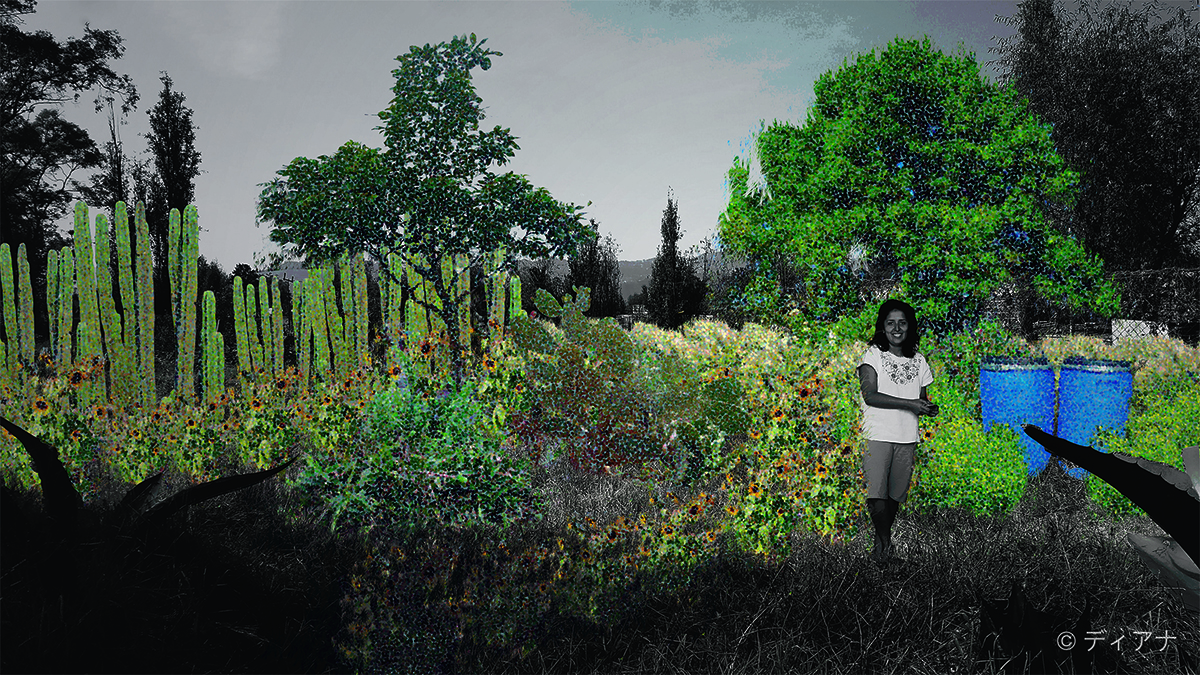
Housing units are located in low flood risk and land subsidence areas in the empty lots near the neighbourhoods where facilities and services are already available. There are three types of housing in relation to the load-bearing capacity of the soil. From multifamily housing in two levels, single housing in one level and villas in a larger area.
The three typologies consist of three elements: the core, the non-programmed space, and the garden. The core is where all the services are located, it is placed in the center of the plot. The non-programmed space is understood as an extension of the core which can be used as a living space or as an area for production. Most of the existing housing units have a space for production on the ground floor. This flexible space is provided with the intention of protecting the way of life the population had before displacement in the neighbourhood. The garden is a place for small-scale agricultural production in the medium a high density housing and in a larger scale for the low density housing. It can be also used as an area for composting, re-creating the system in a small scale. Food is produced there, the remaining materials are composted and then this compost is layered on top of harvesting areas.
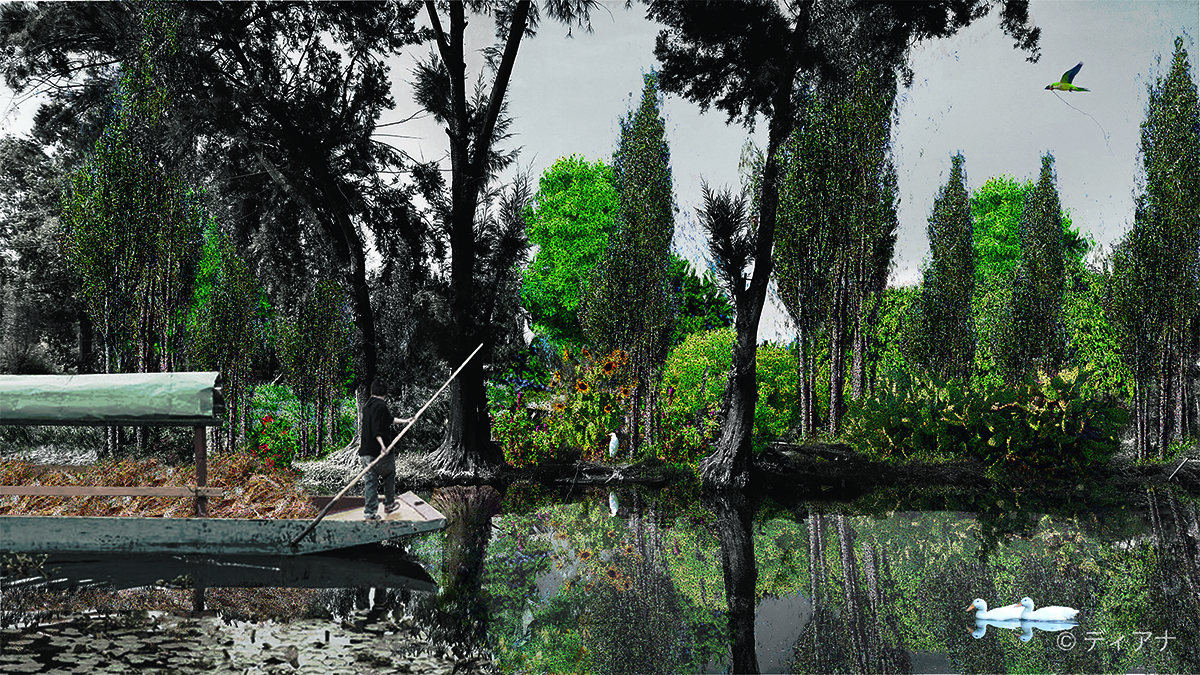
In house small-scale harvesting and composting will be promoted. Help regarding any question about these two systems will be provided through the local association or ‘tequio’. This tequio exists already in the community; it is in charge of the cleaning and maintenance of the neighbourhood. This help will be primarily given through a handbook that will explain the material collection system from the housing to the composting piles.
Regarding the housing units, the handbook explains how to start your own garden if there is not one already grown by the family and how to build a composting container. There will be available a catalogue containing endemic species that have edible fruits; trap crops to protect the plants from common pest and to avoid the use of chemicals; and plants that have a sweet smell to surround the composting container in case of unpleasant odours.
It will also provide an explanation on how to build a plant-based composting container from drums, garden netting, timber or brick walls. And it will detail the process of small-scale composting according to the Food and Agriculture Organisation of the United Nations (FAO).
4.3 Composting Piles
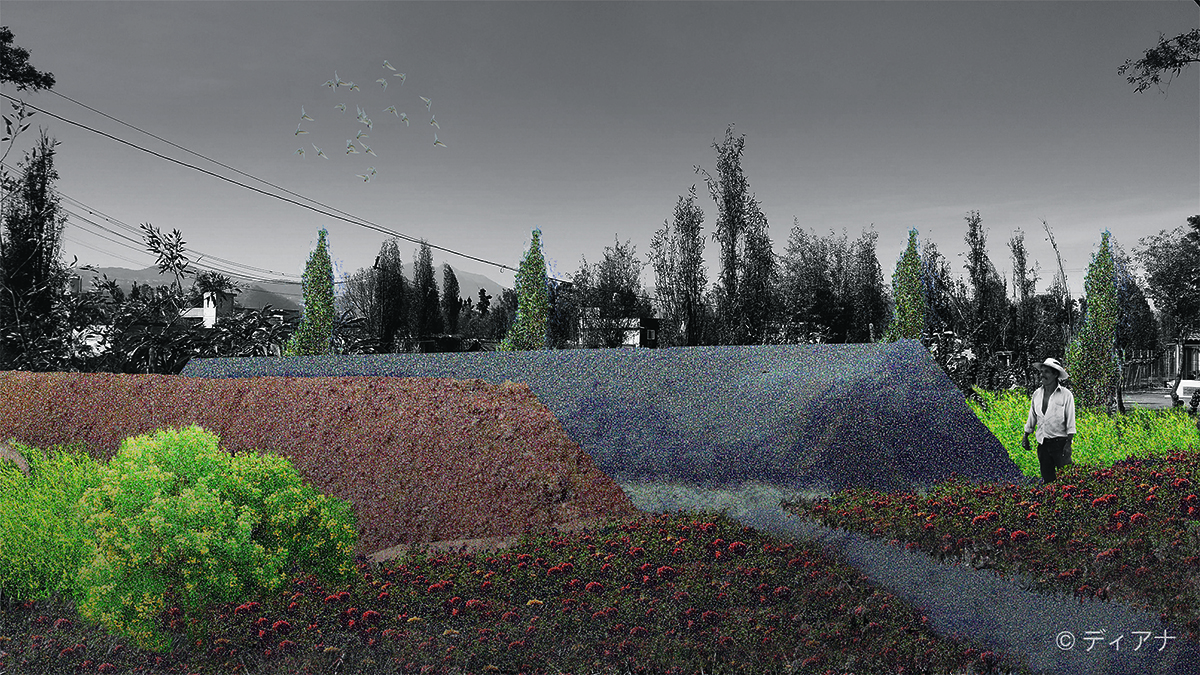
The type of waste that the community is able to manage completely locally is organic materials. There will be several composting piles located in the green core of protected natural areas in order to manage this type of waste. Farming organic materials and urban organic materials will be composted in differentes piles according to their composition; plant-based or animal materials.
Besides managing the agricultural and organic waste, dividing it from the other urban waste, this area for composting in the core will be the principal element in the regeneration of the wetlands. The floating beds (chinampas) where the site is located were built by the accumulation of layers of mud and dried aquatic plants. They were anchored to the ground with the roots of ‘ahuejote’ trees. The compost produced on site will serve as a complementary layer to the historical ones, adding nutrients to warranty fertile soils for agriculture. These nutrients are distributed to the agro-industrial land through the water of the canals.
4.4 Sorting Plants
Local sorting facilities will be designed, in order to cut down the process from door-to-door collection to recycling centers. Waste will be sorted from the beginning giving it visibility in order to avoid ‘the magical act of disappearance’ every time a material is thrown away. These eight sorting plants distributed in the area will also provide a plaza that allows the community to gather which is not currently possible. These plazas will be water squares that collect rainwater in case of extreme rainfall events. The sorting plant will have the suitable characteristics to serve as a seasonal water storage unit to provide water to the community which already faces water shortage.
The sorting plant is also a response to the lack of space for sorting locally; for it to happen in a formal setting and as a valuable means of living.I understand the sorting plant not as a public facility but as another typology of the housing units which happens to have sorting as its kind of production in the non-programmed space. The people in charge live there and their means of living is through the selling of materials to private companies that recycle waste, which is a well-paid labor in this future scenario. The difference of this housing typology is its ‘public components’ that is the water square for community gathering for events like markets were people can sell what they harvest and in case of rain events, water is collected and stored in order to provide water for the community in times of scarcity.
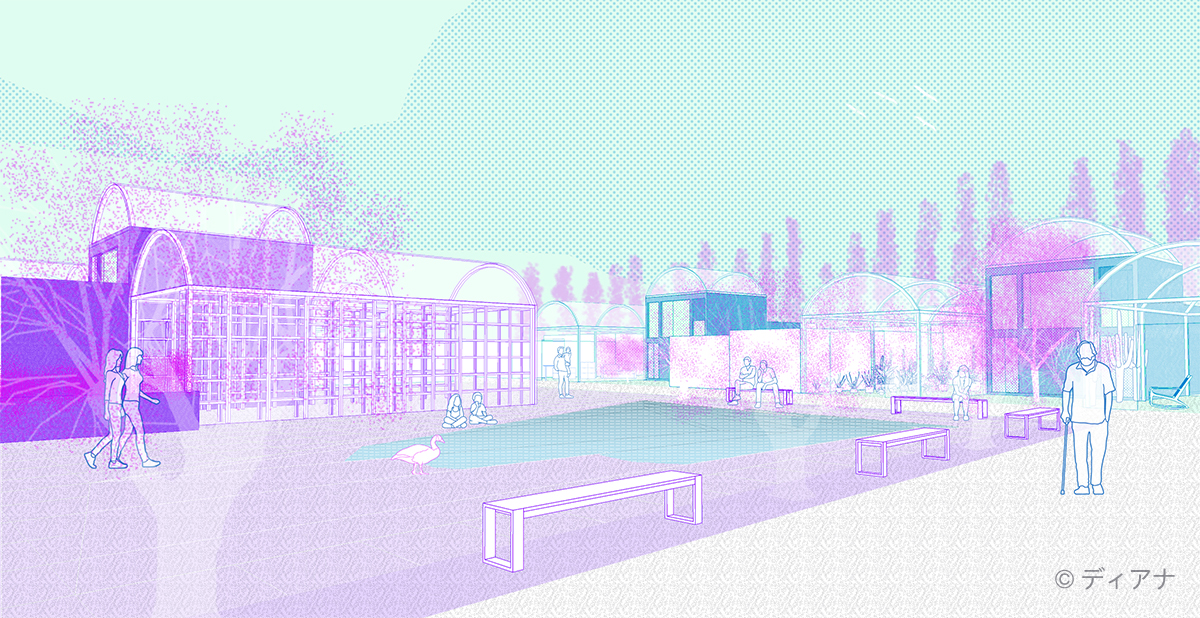
The process of sorting will be introduced to the community through the handbook produced collectively with the ‘tequio’. Though in-house composting will be encouraged, if a composting container is not preferred, the organic materials can be taken to the sorting facilities. On the other hand animal organic materials must be taken to the sorting plants for if they are not composted properly they might cause infections. The community takes their materials to the sorting plant by themselves or they can pay for the service in order for someone to collect it.
In the sorting plant the materials are sorted accordingly. There will be a special place to layer two small composting piles, one for plant-based organic materials and the other for animal organic materials. This will be surrounded by plants that have a sweet smell in order to prevent odours from spreading to the public space. Every plant will have access to the canals so that the small composting piles can be collected and taken to the composting piles located in the center of the area. The inorganic materials will only be sorted for they can be hardly handled locally. Inorganic materials are then taken to be recycled by private companies which are already available. Every sorting plant has car access so the truck can come to pick up the materials.
Then, with these changes, waste is handled locally and autonomously so that the government does not have to collect the waste. There is a differentiation on the two types of waste that are mainly produced in the area agricultural and urban waste. And trucks can access the areas where they have to collect materials.
